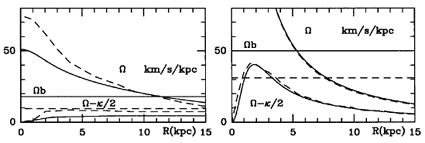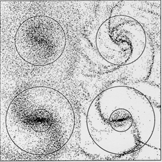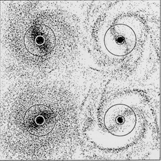


11.3. Bars in Early and Late-type Galaxies
Elmegreen & Elmegreen
(1985,
1989)
have shown that the nature of bars
changes along the Hubble sequence. First, spiral galaxies with
early Hubble types tend to have bars that are longer relative to the
size of the optical disk and the turnover radius of the rotation
curve, compared to late-type barred galaxies; second, early-type bars
are more uniform in intensity relative to the outer disk light profile,
compared to bars in later Hubble types. The spirals surrounding these
bars also differ, with a tendency toward grand design two-armed spirals
occurring for the early types, while the later types have a more
multiple-armed or flocculent structure, as in nonbarred galaxies. The
bar and spiral-arm amplitudes differ along the Hubble sequence too,
with stronger bars and radially decreasing spiral-arm amplitudes in
early type SB or SAB galaxies, and weaker bars with radially increasing
spiral-arm amplitudes in late types.
These observations suggest that bars in early-type galaxies extend to
corotation, where they drive two-armed spirals at the same pattern speed
out to the outer Lindblad resonance, and that bars in late-type
galaxies could end well inside CR, possibly as far in as the inner
Lindblad resonance for the outer spiral pattern, and that these outer
spirals are not always driven by bar.
The problem of the extent of bars has long been debated in the
literature.
Contopoulos (1980)
has argued that bars should extend up
to their corotation, or slightly inside, up to the 4 / 1 resonance:
inside CR, the main stable periodic orbits are parallel to the bar, and
bars are composed of slightly elongated orbits trapped around periodic
orbits. Periodic orbits are perpendicular to the bar outside CR. Weak
bars could still form by crowding effects in that case, but in the case
of strong bars, orbits become stochastic outside corotation, which
supports the bar confinement inside CR. In N-body simulations, no bar
has been seen outside its corotation.
In the point of view developed by
Lynden-Bell (1979),
and further by
Pasha & Polyachenko
(1994)
and Polyachenko
(1994; see also
Polyachenko 1996 and
Polyachenko &
Polyachenko 1996),
bars are made of
near-resonant orbits at the inner Lindblad resonance. The predicted
pattern speed is then always below the maximum of  -
-  / 2,
since the precessing rate of an elongated orbit is lower than the
nearly axisymmetric one, and the pattern speed is now an average of all
precessing rates of the orbits in the bar. The bar is also predicted to
end near ILR, far before the corotation radius. This scenario has not
yet found support from N-body simulations.
/ 2,
since the precessing rate of an elongated orbit is lower than the
nearly axisymmetric one, and the pattern speed is now an average of all
precessing rates of the orbits in the bar. The bar is also predicted to
end near ILR, far before the corotation radius. This scenario has not
yet found support from N-body simulations.
Petrou &
Papayannopoulos (1986)
have also proposed that bars are
shorter than their corotation. This was meant essentially to
resolve the problem of the position of dust lanes in the
concave side of the arms, in strongly barred galaxies. If dust lanes
trace shocks experienced by the gas as it enters the arms, their
position in the concave side means that the arms are inside corotation.
Since they are outside the bar, the latter must end well inside its CR.
They claim that in very strong bars, there can exist a 1 / 1 resonance,
and that orbits become stochastic outside the 1 / 1 radius. The bar
will then end at this radius, well inside CR. Other solutions
have been proposed to solve the same problem; one of them is the
existence of two different pattern speeds for the bar and the spiral
(Sellwood & Sparke
1988).
Combes & Elmegreen
(1993)
have studied by N-body simulations the
properties of bars along the Hubble sequence. Basically, two models
of galaxies were used, differing by their bulge-to-disk mass ratio
(less than 10% for late-types, and equal to 2 for early-types).
In any case, the bar pattern speed adjusts as a compromise of
the precession rates of all trapped orbits. It is always very near the
maximum of the  -
-  / 2 curve, slightly higher at
the beginning, and lower at the end of bar formation, when the bar reaches
a steady-state (Figure 63).
/ 2 curve, slightly higher at
the beginning, and lower at the end of bar formation, when the bar reaches
a steady-state (Figure 63).
Figure 63. Rotation curves for late and
early-type galaxy models, compared with the bar pattern speed. The
initial values are full lines, while the final values are dashed
lines. Left: late-type model; Right: early-type (from
Combes & Elmegreen
1993).

|
For early-type galaxies, the bar ends slightly inside corotation, as
was frequently observed in N-body simulations. The bar is strong,
non-linear, and ergodicity outside CR prevents the bar extension. The
bar saturates inside, trapping all possible orbits, which explains the
flat-topped profile. Bar growth is slow, however, due to the massive
bulge and its stabilizing effect.
For late-types, the bar ends far inside CR, at about the inner Lindblad
resonance. The pattern speed is so slow (corresponding to the low
precessing rates  -
-  / 2) that corotation is pushed
outside of the optical disk. The bar stops growing because of a lack of
particles outside corotation which can receive angular momentum
(cutting the bar amplification mechanism). The bar has a radial
exponential profile, following the optical disk profile, since its
growth has prematurely ended (cf. Figure 64).
/ 2) that corotation is pushed
outside of the optical disk. The bar stops growing because of a lack of
particles outside corotation which can receive angular momentum
(cutting the bar amplification mechanism). The bar has a radial
exponential profile, following the optical disk profile, since its
growth has prematurely ended (cf. Figure 64).
Figure 64. Locations of resonances (ILR and
CR, circles) in late (a) and early-type (b) galaxies
(Combes & Elmegreen
1993).
In each case, stars are shown at left, and gas at right.

| 
|
| a
| b
|
The shape of the bar for late-types is also found to be more squarish
(m = 4 term larger than in early-types). This can be understood in
terms of orbits, since the x1 orbits supporting the bar
are rounder when the axisymmetric background is stronger
(Contopoulos 1988).



 -
-  / 2,
since the precessing rate of an elongated orbit is lower than the
nearly axisymmetric one, and the pattern speed is now an average of all
precessing rates of the orbits in the bar. The bar is also predicted to
end near ILR, far before the corotation radius. This scenario has not
yet found support from N-body simulations.
/ 2,
since the precessing rate of an elongated orbit is lower than the
nearly axisymmetric one, and the pattern speed is now an average of all
precessing rates of the orbits in the bar. The bar is also predicted to
end near ILR, far before the corotation radius. This scenario has not
yet found support from N-body simulations.





